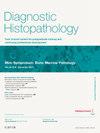Rare variants of mycosis fungoides: a practical approach with emphasis on differential diagnosis
引用次数: 0
Abstract
Mycosis fungoides (MF) is the most common form of primary cutaneous T-cell lymphoma, representing around 50% of all primary cutaneous lymphomas. Its incidence in the United States is estimated at 0.52 per 100,000 cases annually, with a male-to-female ratio of 2:1. MF predominantly affects adults, with a median age of onset between 55 and 60 years. The classic form is characterized by scaly erythematous patches and plaques, which may evolve into tumor stage, signifying more advanced disease with poorer overall survival. Large cell transformation (LCT) can occur at any stage, resulting in more aggressive disease with a median overall survival of 19–36 months. MF can mimic various inflammatory dermatoses, such as eczema and psoriasis, complicating early diagnosis. Uncommon variants like folliculotropic MF (FMF) and syringotropic MF (STMF) exhibit unique clinical and histopathological features, further broadening the differential diagnosis. FMF, characterized by follicular involvement, has a poorer prognosis compared to conventional MF. STMF involves lymphocytic infiltration of eccrine structures and typically presents on the extremities. Pagetoid reticulosis (PR) and granulomatous slack skin (GSS) are rare variants of MF, each with distinct clinical and histological presentations. Accurate diagnosis often requires a multidisciplinary approach due to the overlapping features with other neoplastic and inflammatory conditions. This review highlights the key histopathological features of these rare MF variants and discusses their differential diagnosis.
蕈样真菌病的罕见变异:一个实用的方法,强调鉴别诊断
蕈样真菌病(MF)是原发性皮肤t细胞淋巴瘤最常见的形式,约占所有原发性皮肤淋巴瘤的50%。其在美国的发病率估计为每年每10万例0.52例,男女比例为2:1。MF主要影响成年人,发病年龄中位数在55至60岁之间。经典形式的特征是鳞状红斑斑块和斑块,可能演变为肿瘤阶段,这意味着疾病更晚期,总体生存期更差。大细胞转化(LCT)可发生在任何阶段,导致更具侵袭性的疾病,中位总生存期为19-36个月。MF可以模拟各种炎症性皮肤病,如湿疹和牛皮癣,使早期诊断复杂化。罕见的嗜滤泡性MF (FMF)和嗜淋巴性MF (STMF)表现出独特的临床和组织病理学特征,进一步拓宽了鉴别诊断。FMF以累及滤泡为特征,与传统MF相比预后较差。STMF涉及淋巴细胞浸润的内分泌结构,通常出现在四肢。page -样网状病(PR)和肉芽肿性松弛皮肤(GSS)是MF的罕见变体,每一种都有不同的临床和组织学表现。由于与其他肿瘤和炎症条件的重叠特征,准确的诊断通常需要多学科的方法。本文综述了这些罕见MF变异的主要组织病理学特征,并讨论了它们的鉴别诊断。
本文章由计算机程序翻译,如有差异,请以英文原文为准。
求助全文
约1分钟内获得全文
求助全文
来源期刊

Diagnostic Histopathology
Medicine-Pathology and Forensic Medicine
CiteScore
1.30
自引率
0.00%
发文量
64
期刊介绍:
This monthly review journal aims to provide the practising diagnostic pathologist and trainee pathologist with up-to-date reviews on histopathology and cytology and related technical advances. Each issue contains invited articles on a variety of topics from experts in the field and includes a mini-symposium exploring one subject in greater depth. Articles consist of system-based, disease-based reviews and advances in technology. They update the readers on day-to-day diagnostic work and keep them informed of important new developments. An additional feature is the short section devoted to hypotheses; these have been refereed. There is also a correspondence section.
 求助内容:
求助内容: 应助结果提醒方式:
应助结果提醒方式:


